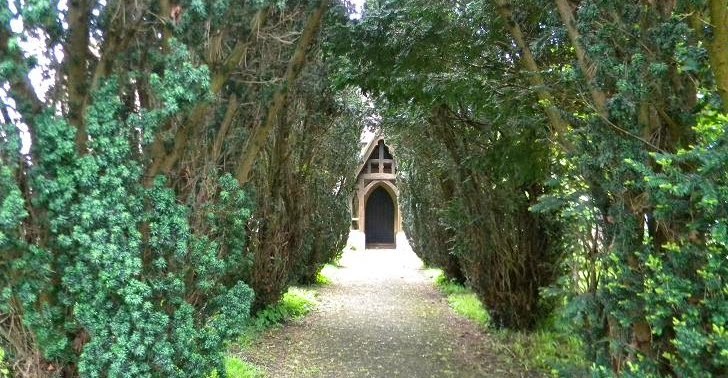Gunpowder, treason and plot. A body discovered, buried with Scottish coins. Ghosts. Priest holes. Not to mention a beautiful church of 12th century origin where my father was rector during the 1960s. The village of Huddington (Hudda’s Land. He was a Saxon warrior who visited in the early 8th century and liked the place so much he moved in) has it all, which is surprising for a community whose population is no more than three dozen souls.
Mee describes the place as “strangely remote in this quiet country” and he was right then and now. The Victorian “County History” only offers us the rather dull geographical description of Huddington as being “In the valley of Bow Brook and the whole parish is low-lying.”At the centre of the village there is an unassuming and unsigned crossroads, easily missed when traveling east on the road from Droitwich to Grafton Flyford. Turning left will lead up the single village street, a cul de sac of six houses and Hall Farm, and a bridle path that leads to my old home some two miles away over the hill. But turning right is a step back into one of the most exciting chapters in English history.
The unmade road leads directly to Mill Farm, but the small wooden sign on the rather grand stone gatepost tells us that this is also the entrance to Huddington Court. And, of course, the way to the Church of St James. As a visitor crosses an unnamed tributary of the Bow Brook and walks south the black and white timbered belfry of the church can be seen above the tall hedges.
And after a hundred metres, turning right through an even grander gate, the visitor comes face to face with Huddington Court.
The oldest parts of this delightful country pile date from the 1340s but the remainder of the house was built a century later. It was part of the manorial estate of the Hoddington family (Hudda’s lineage) until the middle of the 15th century when it passed by marriage into the ownership of the Winter (or Wintour) family. Now for the gunpowder, treason etc.
The history of the Gunpowder Plot of 1605 may be read in countless sources, but to put it in a nutshell: It was a failed Roman Catholic conspiracy to assassinate King James the First by blowing up the House of Lords during the State Opening of Parliament. Now without excusing the intended use of a weapon of mass destruction it must be said that “Catholics” (sic) were having a hard time of it under an increasingly “Protestant” (sic iterum) establishment. But you must read about that for yourselves. Back to Huddington…
The Winter brothers, Robert and Thomas, were a part of this plan. Robert was the owner of Huddington Court, and although it cannot be proved it is entirely reasonable to suggest that many of these conspiratorial plans were drawn up in that “strangely remote” village. Who knows – perhaps even Guy Fawkes was there. What is known is that after the plot was discovered the Court was the place to which Thomas Winter and others fled. Journals record that a group of exhausted men arrived at Huddington on horseback around two o’clock in the afternoon on 6th November 1605. After brief rest, and receiving communion from a supportive priest, they left for Staffordshire (and capture) in the middle of the night.
There is a legend that Robert Winter’s widow Gertrude still walks the driveway (known as Lady Winter’s walk) at night awaiting her husband’s return.
But let’s leave the Court behind and walk across the lush and manicured lawn to the church. Through the rustic lych-gate and into the 15th century porch. A heavy door opens with the same loud grating sound that I remember from my boyhood. And we’re in!




